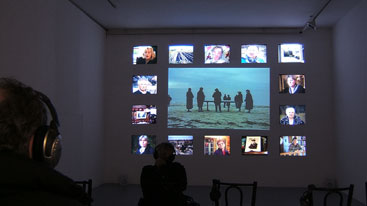
Born in 1928 in Brussels (BE)
Died in 2019 in Paris (FR)

2005
Video installation, colour, sound
Dimensions variables
Year of Purchase: 2004
Filmmaker Agnès Varda has not written many films for showing in art circles. Les Veuves de Noirmoutier (The Widows of Noirmoutier) is one of her first attempts, contemporaneous with her installation Patates Cœurs (Spuds Hearts), taken from her successful documentary Les Glaneurs et la glaneuse (Men and woman gleaners). Made up of 15 films shot on the island of Noirmoutier, this wall of monitors draws a constellation of portraits around one larger main screen. This silent central film is haunted with the black silhouettes of women moving in circles on a beach. In the middle of this mute choir, recalling the Fates in procession, there is a bare table. It is reminiscent of family meals in former times, and the end of an age. For these women are widows. Each has a turn to speak in one of the fourteen films that form the surroundings for this picture. It is up to the visitor to choose whether or not to take a headset and listen to their short accounts. ‘These portraits are silent, explains Agnès Varda, because society does not hear these widows. This was the motivation behind this work. Absence is a great subject in our society’1, analyzes the filmmaker who has often depicted her obsession with death since her film Cléo de 5 à 7 (Cleo from 5 to 7), made in 1961.
In their forced loneliness, these women tell of the empty feeling, their memory of the other person, in simple, concrete accounts with the odd picture in support – here a wedding photograph, there a painting in the sitting-room, or a boat in the harbour. They say how cold the bed is, very cold now, or why they will never sleep where the dead person used to sleep. Another, young one feels as thought she has been ‘amputated: I form a couple with a dead man, which is pretty unusual’. Discreetly, Varda insists on ‘their pithy phrases’: ‘You feel you’re living as a half’, we hear.2 She is there as well, included in this frieze of fourteen portraits; she is there as the widow of filmmaker Jacques Demy whose picture makes the odd fleeting appearance; but she says nothing. ‘I feel the writer of a documentary must be a part of the subject’, she pleads. In Glaneurs, in this way I was sharing the precariousness of the characters, through my old age’. Agnès Varda has always viewed the documentary form as being a subjective questioning, refusing any distance between the author and her subject. Testimony to this are documentaries like Mur, Murs (Wall, Walls,1982) or her biographical portraits, from Jane B par Agnès V (1987) to Jacquot de Nantes (1990). A late arrival on the art scene, in 2003, she who was a pioneer in taking the women’s lib movement to attainment followed a similar path to the one taken by filmmaker Chantal Akerman. If she does not deploy her documentaries within the space the way her colleague does, like her she has found in the video installation a new possible approach to the image and narrative; also a way of escaping the authoritarianism of the montage. Playing on the contrast between the closed space and the vast space of the ocean, with Les Veuves de Noirmoutier she offers a new mode for speech to rise up and a new position for the viewer, invited to make more use of their free will and choose their distance from the subject.
Emmanuelle Lequeux
1 In entretien d’Agnès Varda avec Frédéric Bonnaud, dans l’émission «Charivari», France Inter, 1er juillet 2004.